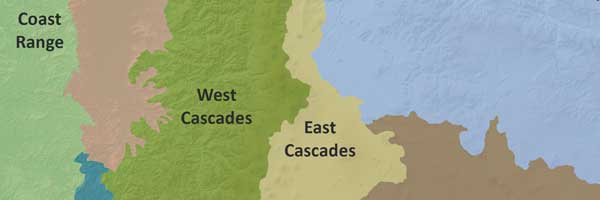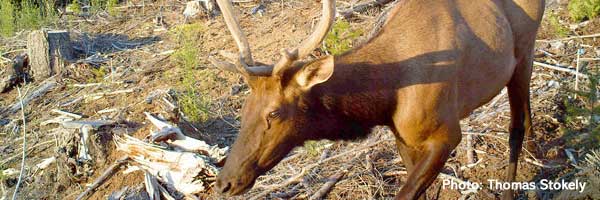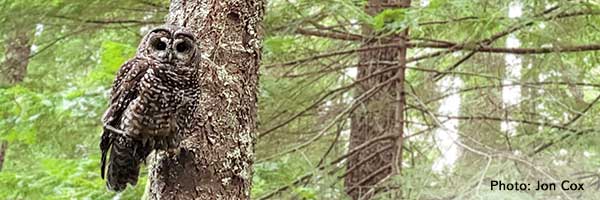Wildlife and Habitat Management
CREATING A HOME FOR OREGON'S NATIVE WILDLIFE
Regardless of where you live or how much property you own, you’re part of providing habitat for wildlife. And there are many things you can do to enhance wildlife habitat. This can range from putting up birdhouses to restoring a native endangered ecosystem like an oak savannah. What you choose to do will depend on your property, your land management objectives and your resources, including money and time. The information below will help you intentionally manage for wildlife on your property.
LEARN MORE ABOUT MANAGING FOR WILDLIFE ON YOUR PROPERTY
There are many resources to help you manage intentionally for wildlife on your property. You can get guidance from many sources in Oregon, including the Oregon Forest Resources Institute, Oregon State University, the Oregon Department of Fish and Wildlife, the Woodland Fish and Wildlife Group and many others. You can click on the buttons below to learn more.
| For more information, please contact: Fran Cafferata, Certified Wildlife Biologist, Cafferata Consulting |
JUMP TO:
 |
HABITAT |
 |
OREGON ECOREGIONS |
 |
WILDLIFE DAMAGE |
 |
REGULATED WILDLIFE |
 |
SPECIES |
INTENTIONAL MANAGEMENT OF WILDLIFE HABITAT
Wildlife habitat is highly variable. In fact, the entire landscape may be considered habitat, because different wildlife species and communities interact with the land and one another in multiple ways – from a drainage basin to a river valley, to a watershed within the valley, to a riparian area associated with a single stream. Many species will use a variety of habitat types to complete the functions of their daily lives (e.g., foraging and nesting may utilize two or more habitat types). And, more broadly, species may migrate or expand their territories during certain times of the year as part of their life cycle. Habitat is a shifting mosaic over time, as forests and other landscapes move through natural and human-altered timelines.
Many habitat goals are mutually exclusive – what improves conditions for one species of wildlife may degrade them for another. Not every wildlife species is (or can be) present on every acre at any point in time. We suggest that forest landowners and managers consider the array of opportunities presented by their forest’s ecological context, along with their own management objectives, and select those efforts that have a reasonable chance of success.
| Explore the following resources to learn more: |
| Wildlife in Managed Forests: Oregon Forests as Habitat As the cornerstone publication for the Oregon Forest Resources Institute's Wildlife in Managed Forests series, this booklet provides a background and context for better understanding the role managed forests play in providing habitat for wildlife. The reader is introduced to an overview of priority actions for wildlife that can be implemented on any age or size of forest. It also provides forest landowners with suggestions for wildlife management planning goals, and employs a series of case studies of Oregon landowners who have applied these techniques and goals on their own lands. |
| Family Forests and Widlife: What You Need to Know Family forest landowners have many reasons for owning forests; enjoying wildlife and providing wildlife habitat consistently rank as top motivators. This publication, the cornerstone in a series by the Woodland Fish and Wildlife Group, will give you some ideas on where to begin as you decide how to best manage your woodland for wildlife habitat. |
| An Introduction to Wildlife Habitat Enhancement An introductory video from the Oregon State University Extension Service. |
| Steps to Improving Wildlife Habitat on Your Property A video full of tips and ideas for encouraging wildlife on your property. Provided by the Oregon State University Extension Service. |
| Fact Sheet: Wildlife Why do forest animals live where they do? This one-page fact sheet explores the relationship between forest ages and the animals that live in them. Provided by the Oregon Forest Resources Institute. |
| Forest Fact Break: Wildlife 90-second animation from a series created by the Oregon Forest Resources Institute. |
SPECIFIC HABITATS OF OREGON

OREGON ECOREGIONS
Knowing more about the ecoregion you live in can help you make choices about the actions you might take to manage for the wildlife and habitat found on your property. The Oregon Department of Fish and Wildlife (ODFW) Conservation Strategy includes the following ecoregion descriptions:
Basin and Range
The Northern Basin and Range ecoregion is sagebrush country.
Blue Mountains
Oregon’s Blue Mountains ecoregion is a wonderland of mountain ranges, valleys and plateaus.
Coast Range
Oregon’s Coast Range ecoregion is made up of unique and diverse habitats ranging from sandy dunes to lush forests, from tidepools to mountain streams, and from grasslands to oak woodlands.
Columbia Plateau
The Columbia Plateau, made up entirely of lowlands, is—and has been—greatly influenced by its river.
East Cascades
The East Cascades ecoregion extends from just east of the Cascades summits to the warmer, drier high desert to the east.
Klamath Mountains
The Klamath Mountains ecoregion boasts a wonderful diversity of species, including many species found only locally.
West Cascades
The West Cascades ecoregion has been shaped by its volcanic past.
Willamette Valley
The Willamette Valley ecoregion is the most urban in the state. It is also the fastest-growing ecoregion—it has nine of Oregon's 10 largest cities.
The Oregon Forest Resources Institute's A Guide to Priority Plant and Animal Species in Oregon Forests is organized by ecoregion, and may be helpful in learning more about the species habitats found in your ecoregion.

WILDLIFE DAMAGE
An integrated wildlife damage management approach uses a wide variety of methods and techniques to prevent and reduce damage to private property caused by wild animals. Managing wildlife damage may include modifying human activity and practices, manipulating habitat and taking action to change the behavior of wildlife or reduce their presence and impact.
For more information on animal damage and conflict with wildlife, contact the U.S. Department of Agriculture's Animal and Plant Health inspection Service (APHIS) Wildlife Damage Department
Phone: 503-326-2346, Toll Free: 1-866-4USDAWS
| Explore the following resources to learn about wildlife damage: |
| OSU Extension Living with Nuisance Wildlife Publication This publication discusses ways to reduce problems with unwanted wildlife around homes. It covers species from rodents to big game, bears and cougars. Recommendations include eliminating food and shelter, trapping, hunting, fencing and hazing. |
| APHIS: Wildlife Damage Management Technical Series This series highlights individual wildlife species or groups of species that cause damage to agriculture, property and natural resources, and/or impact human health and safety. It also includes selected topics such as bird dispersal techniques, wildlife hazards at airports and pesticide registration. Articles discuss the basic biology and ecology of the species, specific damage issues and conflicts, and current damage management tools and techniques to prevent and resolve conflicts. |
| Wildlife in Managed Forests: American Beaver This publication on the American beaver is part of Oregon Forest Resources Institute's Wildlife in Managed Forests series, developed for foresters, wildlife managers and landowners as well as interested parties such as conservation organizations, regulators and policymakers. Publications in the series synthesize current research findings about the habitat requirements and ecological roles of various wildlife species in Oregon and the Pacific Northwest. |
| Wildlife in Managed Forests: Deer and Elk This 24-page publication part of the Oregon Forest Resources Institute’s Wildlife in Managed Forests series for forest landowners and managers. Each publication in the series reports on what is known about habitat requirements and ecological roles of various wildlife species in Oregon and the Pacific Northwest. This one addresses deer and elk population dynamics, herd productivity, nutritional needs and response to human disturbance |

REGULATED WILDLIFE
There are many species of wildlife in Oregon that receive special protections. These protections might be through the Oregon Department of Forestry, the Oregon Department of Fish and Wildlife, the United States Fish and Wildlife Service or the National Marine Fisheries Service. In addition, wildlife may receive special protections through voluntary actions or certification programs such as the American Tree Farm System or Sustainable Forestry Initiative.
| Explore the following resources to learn about regulated wildlife in Oregon: |
| United States Fish and Wildlife Service A list of federally listed, proposed, candidate and delisted species, and species of concern, by state. |
| Nesting Periods for Species in the Oregon Forest Practices Act This chart summarizes the nesting periods for bird species protected by the Oregon Forest Practices Act. |
| USFWS Information for Planning and Consultation (IPaC) Website IPaC is a project planning tool that helps you identify potential protected species near your property. |
| Wildlife in Managed Forests: Oregon Forest Practices Act Reference Series These fact sheets help forest managers plan management activities that have the potential to impact forest-dwelling birds such as the bald eagle, marbled murrelet or osprey. The fact sheets specifically outline the nesting seasons of all the birds, plus a few more species that are protected by the OFPA. WIMF: Oregon Forest Practices Act Reference Series is an Oregon Forest Resources Institute publication. |
| A Guide to Priority Plant and Animal Species in Oregon Forests This revised and updated publication is designed to assist forest landowners and land managers understand how forests provide habitat for different wildlife and plant species. It describes the specific habitat requirements of selected species found in forested habitats across all ecoregions in Oregon. This is an Oregon Forest Resources Institute publication. |
| Hawk, Eagle and Osprey Management on Small Woodlands Raptors – or birds of prey – include hawks, eagles and osprey. Raptors benefit from small woodlots because most of their food is small mammals along with some birds and reptiles. This publication discusses raptors, their habitat and management techniques for small woodlands. |
| Managing Pacific Northwest Forests for Band-Tailed Pigeons The welfare of the Pacific Coast population of the band-tailed pigeon is directly related to forestland management in Oregon and Washington, and is therefore of interest to small forestland owners. This publication discusses the species’ history, population status and management. |
| ODFW Threatened, Endangered and Candidate Fish and Wildlife Species The state of Oregon and the federal government maintain separate lists of Threatened and Endangered (T&E) species. These are species whose status is such that they are at some degree of risk of becoming extinct. |

SPECIES
In addition to managing for wildlife habitat generally, you can also research wildlife specifically and make choices that are known to benefit a single species or a group of species. The resources in this section are geared toward specific species.
Oregon Conservation Strategy
The Oregon Conservation Strategy, developed by the Oregon Department of Fish and Wildlife, is an overarching plan to conserve Oregon’s fish and wildlife and their habitats. It combines the best available science and conservation priorities with recommended voluntary actions and tools for all Oregonians to define their own conservation goals.
This 24-page publication part of the Oregon Forest Resources Institute’s Wildlife in Managed Forests series for forest landowners and managers. Each publication in the series reports on what is known about habitat requirements and ecological roles of various wildlife species in Oregon and the Pacific Northwest. This one addresses deer and elk population dynamics, herd productivity, nutritional needs and response to human disturbance
